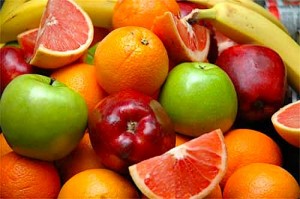Fruit Trees in Palos Verdes
 Question from Maureen:
Question from Maureen:
I’ve been to your talks at Rogers Gardens (looking forward to April). And have your book.
We put in a small orchard of 10 trees 7 years ago. We’re in Palos Verdes about 1 mile from the ocean with a garden that is east facing (not ideal, but can’t be helped)
The grapefruit and meyer lemen perform well. The Valencia orange produces but the fruit is inedible (sour). Peach trees have never produced fruit. Avocado. We have 2 Haas. One produces fruit, but it never ripens and the local vermin/animals get to them before we can. I fertilize with Dr. Earth’s according to your directions.
So, we are ready to remove the peach trees (4) and would like to put in an apple. Possibly fuji? Would a necterine work here? I would like a mission fig too.
Someone at Rogers advised us not to do oranges as they don’t get enough warmth here to sweeten. Do you agree? Possibly I could do a small mandarin or other small fruit?
Answer from Pat:
Most parts of Palos Verdes are cool and coastal, cool winds are frequent. East facing is good for some plants, but you are right, not optimum for fruit trees if the plants are shaded in the afternoon. Could you arrange some kind of reflective heat, like a white wall?
I would cut down the Valencia orange or use it for making marmalade, which is best when made with sour fruit and peel. Re: avocado’s: Consider employing a critter-control company. More fertilizer might help since avocado’s are big feeders needing up to 2 pounds nitrogen annually for a mature tree. I think you would do better using a homemade fertilizer, for example blood meal (strong nitrogen source) with bone meal (for phosphorus) and Sul Po Mag (for potassium) or for nitrogen you could use Alfalfameal, feathermeal, or seedmeals. Unfortunately, all these bring critters. Peaches are seldom good along the coast. You might have a problem, also, with lack of bees for pollination which could be cutting down on fruit.
With afternoon shade, I cannot guarantee success, but I would recommend the following trees: ‘Panamint’ nectarine is usually a winner for home gardens, ‘Meiwa’ kumquat (ask for it at Plant Depot in San Juan Capistrano) is very sweet skin and all, instead of Mission fig, try ‘Brown Turkey’ is the best and easiest fig for coastal zones, and instead of ‘Fuji’ apple, which is not good along coast, try ‘Anna’ with ‘Dorset Golden’, or better yet ‘Ein Schemir’ as pollinator. Another apple good for the coast and it makes the best ever apple pies is ‘Winter Banana’. Name doesn’t sound good but really is an excellent older variety with big apples and easy to grow.
If bees are insufficient, hand pollinate. See you at Rogers!


Thank you so much!!! On the homemade fertilizer, do you have ratio
recommendations? Should I do 33% of each? And that would replace the
nitrogen? Also I’m assuming one pound per feeding, done 2x a year. Or is
it 2 pounds, 2x a year?
A silly question, but my gardener said he would recommend cutting down these
trees and not removing the old tree roots, just planting right next to where
the tree was cut down. It seems to me, that while it’s more work, the root
balls should come out so the new trees have more root space. Your thoughts?
I have lavender surrounding the fruit trees…so hoping my bees will fly up
occasionally and pollinate 🙂 And yes, I’ll see you at Rogers!
Not 33 % each. There are several organic fertilizer recipes in my book with appropriate proportions. Someone wrote and asked for the one I described in a talk. Here is the link:https://patwelsh.com/wpmu/blog/fertilizer/fertilizer-recipe/
When computing how much fertilizer you need to provide 2 pounds nitrogen per year you have to use math for the nitrogen part only. So for example cotton seed meal has 6 or 7 % nitrogen in each pound. Thus to make one pound actual nitrogen you would need 14 pounds of it. Probably you could used less and be all right due to the fact that growing plants organically means the organics in the soil are also producing their own nitrogen.
There are no silly questions, so in answer to the question you think is silly let me say I’m not sure of the answer but can only tell you how it will work. Personally I would dig out the stump and any thick roots around it, otherwise the stump will sprout. The smaller roots will gradually rot and in order to rot they will subtract nitrogen from the soil but not a lot and later when they were fully rotted they would give the nitrogen back. I’m surprised your gardener doesn’t want to remove the stumps. My gardener loves doing jobs like that, but everyone’s different! My gardener loves to prune hedges which is lucky since I have a lot of them, and he loves to dig and plant, but he apparently hates to weed.
Thank you Pat!!!!